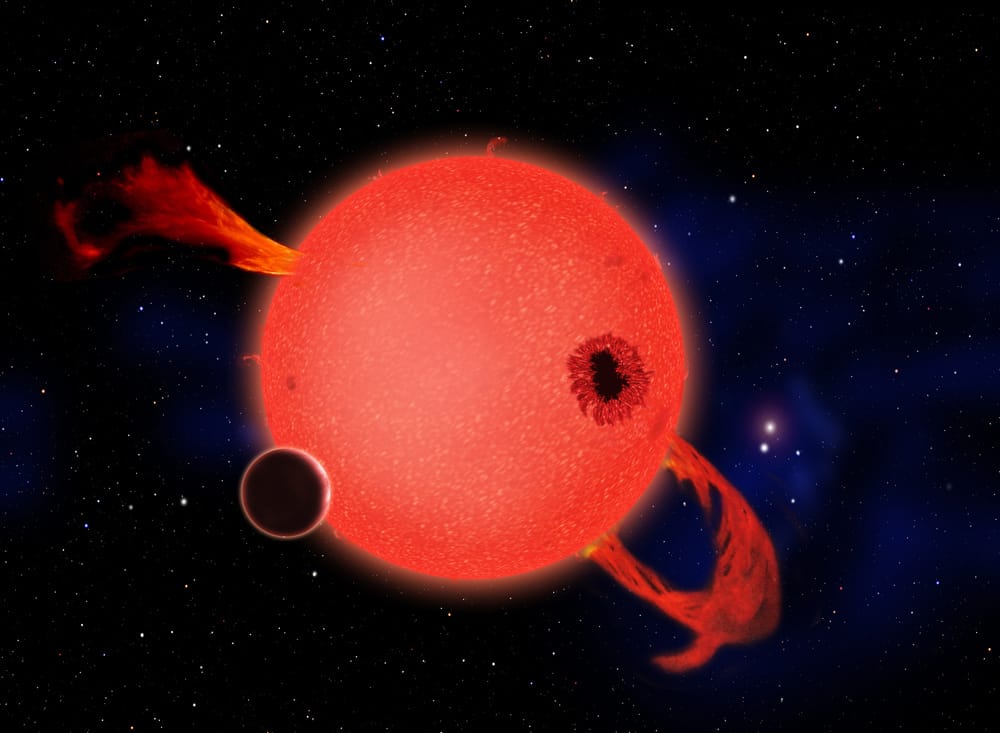- Bad Astronomy Newsletter
- Posts
- An exoplanet reveals its star’s spotty face
An exoplanet reveals its star’s spotty face
Did you know other stars get sunspots? And we can find them via their planets?

The Trifid Nebula and environs. Credit: RubinObs/NOIRLab/SLAC/NSF/DOE/AURA
October 2, 2025 Issue #939
An exoplanet hits the spot… kinda literally
A transiting planet crosses a starspot
I’m fascinated by our ability to detect planets orbiting other stars. The most successful way we have to find them is the transit method, when a planet orbits its host star nearly edge-on from our vantage point, so it physically crosses the star and creates a mini-eclipse. The dip in starlight is measurable, and from that we can get a lot of info like the planet’s size, its orbit size, and more.
And, in some cases, we learn about the star. Like when it has starspots.

Artwork depicting a red dwarf star with a giant starspot and storms erupting off its surface, as well as an exoplanet just starting its transit. Credit: Smithsonian Institute
Starspots are just sunspots on another star. They’re magnetic phenomena. Many stars convect, meaning hot stuff deep inside them rises up to the surface, cools, and then falls back down again. These parcels of material have magnetic fields embedded in them. When they reach the surface the field lines can get tangled, which prevents hot material from sinking back down. It cools, so it gets a little darker compared to the rest of the star’s surface, and we see a black spot. On the Sun these can be smaller than Earth up to huge ones that can be wider than Jupiter.
The star LSPM J1206+1230 (also known as TOI-3884) is a red dwarf about 140 light-years from us. It’s about a third the size and mass of the Sun, and it’s cooler and fainter. It has at least one planet orbiting it, and it’s a funny system. The planet is a super-Neptune, so something bigger than Neptune but smaller than Saturn. It doesn’t orbit around the star’s equator, but is instead in a highly tipped orbit, making a 62° angle with the equator (there can be lots of reasons this happens, though we think it most commonly occurs due to a planet interacting gravitationally with other nearby planets). The thing is, we see the star nearly pole-on, so we see still the planet transiting every orbit.
It’s a deep transit, since the star is small and the planet is big; their size ratio is about 5:1, so the planet blocks a lot of the star, about 4% (most transits show a much smaller dip in light). But the transits are weird.
When a planet moves across a star there’s a characteristic drop in starlight. First the light is steady, then the transit begins and the light drops. It stays that way for a while as the planet moves across the face of the star, then the light goes back up as the planet moves off. We see a lot of variations in this graph due to things like planet size, whether it cuts across the middle of the star or we only see it pass along a chord, and more.
In this case though, it’s really peculiar. Astronomers took a look at it and saw a bump in light during the transit, with the star getting slightly brighter right in the middle of the event! Not only that, the timing changed every time they watched a transit (they occur every 4.5 Earth days), with the bump appearing sometimes near the beginning of the transit and sometimes later on [link to journal paper].
Yup: what they found was a starspot, and a big one. Starspots are dimmer than the stellar surface around them, so when the planet crosses in front of the spot there’s a slight increase in brightness seen, because now the planet is blocking a dim spot on the surface and not a bright one.

Subscribe to Premium to read the rest.
Become a paying subscriber of Premium to get access to this post and other subscriber-only content.
Already a paying subscriber? Sign In.
A subscription gets you:
- • Three (3!) issues per week, not just one
- • Full access to the BAN archives
- • Leave comment on articles (ask questions, talk to other subscribers, etc.)

Reply